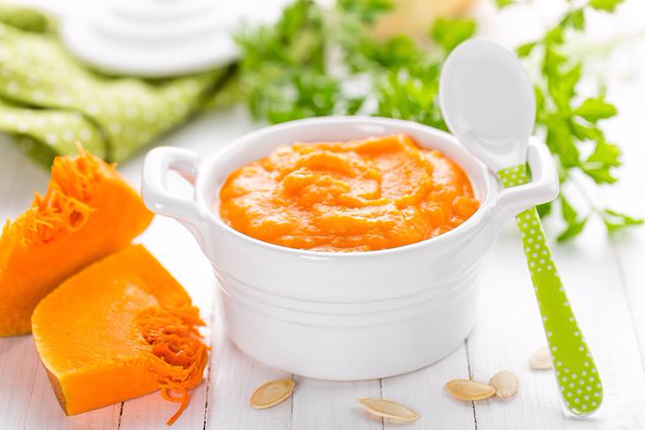Introducing solid foods to your baby is an exciting time! Every parent loves to see the expressions that come from baby tasting a new food. Some of them are looks of pure horror; while others are sheer excitement at the taste.
For many new parents, the process of introducing baby food can seem daunting and filled with contradicting advice.
As a mother of three children, I have chartered the course of introducing food to my kids a few times. Each time is just as exciting as the last experience. I’ve learned a few tricks and tips along the way, to help make the process easier and less confusing.
How to Introduce Baby Food – 7 Things to Know
1. What age should you introduce solids?
Most parents will receive conflicting advice about when to give their child baby food. Plunket New Zealand advises parents to wait until their child is around six months of age. Introducing solids before four months increases the risk of weight gain and obesity. Delaying introducing solids for too long also puts your child at risk of nutrition depletion.
There are some readiness signs you can look for in your child. They should be able to sit in a high chair, or an infant seat with head control. Most babies love to watch their parents eat. Another readiness sign is a child that opens their mouth when they see food, or they may reach out for it.
Children need the ability to move food from the front of their mouth to their throat. If you give your child a bite of baby food and it comes back out, they may not be ready to start. Also, most pediatricians advise waiting until a child has doubled their birth weight before starting solid foods.
2. What foods should you introduce to baby?
Once you decide when to start solid foods, it is time to decide what to give them first! There are a lot of options. Some start with baby cereal. However, I never chose rice cereal as a first food. There’s even some evidence to suggest staying away from starchy foods to begin with.
Many parents start with vegetables because fruits are sweeter. They believe that introducing fruits first may cause a child to dislike the taste of veggies. Most commonly, I begin with giving my kids carrots. Some great first food vegetable options are:
- Carrots
- Green beans
- Peas
- Spinach
- Silverbeet
There is really nothing wrong with opting to start with fruits instead of vegetables! I commonly give fruits as the second or third food to my children. Their excitement with the first bite makes it worth having a camera nearby. Babies love fruits! Some common first food fruit choices are:
- Bananas
- Apples
- Peaches
- Pears
- Avocado
- Plums
3. Opt for Homemade Baby Food
Purchasing baby food is really expensive. Our family chooses organic baby food, and the cost could easily hit $5 or more each day. That means we could spend around $150 per month if we chose to use store bought baby food. Children tend to eat baby food for four to six months; that is a significant chunk of change!
Food manufacturers have large blenders designed for making baby food. While they are nice, a standard blender or immersion blender can do the same thing. In fact, most baby foods can simply be finely chopped, boiled and then mashed with a fork!
It is important to wash and steam most foods before blending. And baby food should be kept in the fridge in airtight containers for only 1-2 days. You can now even buy special refillable baby food pouches for storing!
All baby food recipes are very simple, and can be in just a few minutes. And, personally, I love the combinations I can make, like banana raspberries or baby chicken pot pie!
4. Breastfeeding, bottle feeding, and introducing solids
Whether breastfeeding, or bottle feeding your child, introducing baby food in the right order is important.
Children need breastmilk until they are at least one year old. If you introduce solids the wrong way, you risk your child turning to solids too early, and missing out on the amazing benefits of breastmilk. It’s a similar story with bottle feeding.
What is the right way? The right way to introduce baby food is to remember the saying ‘under one, just for fun’. That means it is best to breast or bottle feed your child first. Then, once they’re satiated, offer them some baby foods just for fun. If they are still hungry, they will happily eat a few bites. If they are full of milk, they will turn their head.
5. Single Ingredients
Food allergies are an increasingly common problem. You want to make sure you catch any reactions to different foods early.
The best practice is to introduce single ingredients at a time. For instance, introduce carrots and apples as separate foods. After three introductions, you’ll have a good idea if your child has any reactions. Once you’re confident they aren’t allergic, you’re free to give them apples and carrots mixed.
6. Gradual Introduction
I start with a slow introduction to baby food. Instead of offering breakfast, I introduce baby food at lunch time, after their nap and a good breastfeeding. In the beginning, they may only take a few teaspoons of food, which is fine. A lot of it will end up on their bib, or the food tray, or the floor!
Once they can eat 50 grams at lunch (around 1/4 cup) I offer 50 grams at breakfast too. Around this time, I give my children baby cereal. Instead of rice, I opt for baby oatmeal mixed with fruit and heated up. My kids always enjoy this! By the time they are nine to ten months, my children can eat two or three meals per day and up to 100 grams of baby food at a time.
7. Finger Foods
Some kids hate the texture of baby food. If you notice after a few weeks that they start to refuse baby food. It may be the texture. Introducing finger foods, once they have mastered the ability to pick food up is safe. Remember to watch your child carefully for choking.
My second son refused baby food after eight months and only ate finger foods (he’s fine by the way).
Introducing solid foods is one of my favourite things in the first year of baby’s life. I love watching them experience new foods and finding the ones they prefer the most. It’s a great time to bond with your baby and have some great laughs together. Introducing baby food is a time to celebrate, and to get ready for even more laundry…
For more expert advice on introducing solids and baby food recipes, check out our Feeding baby section.





